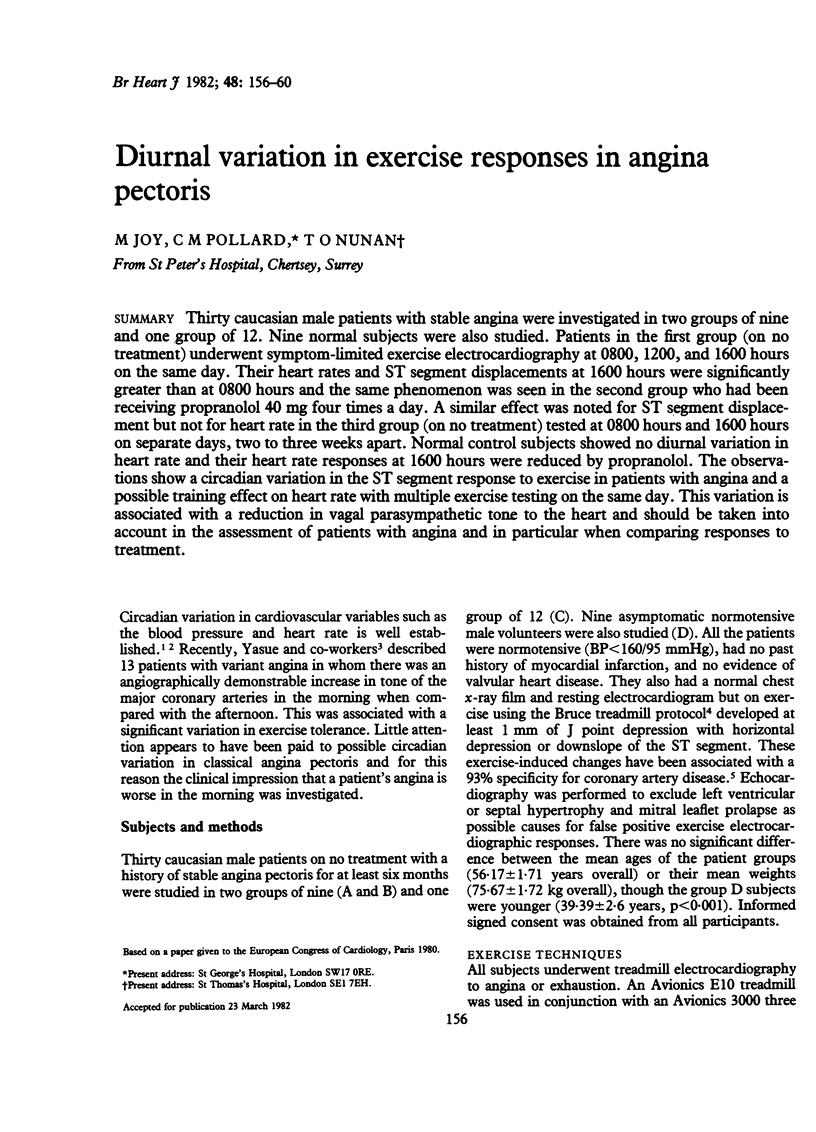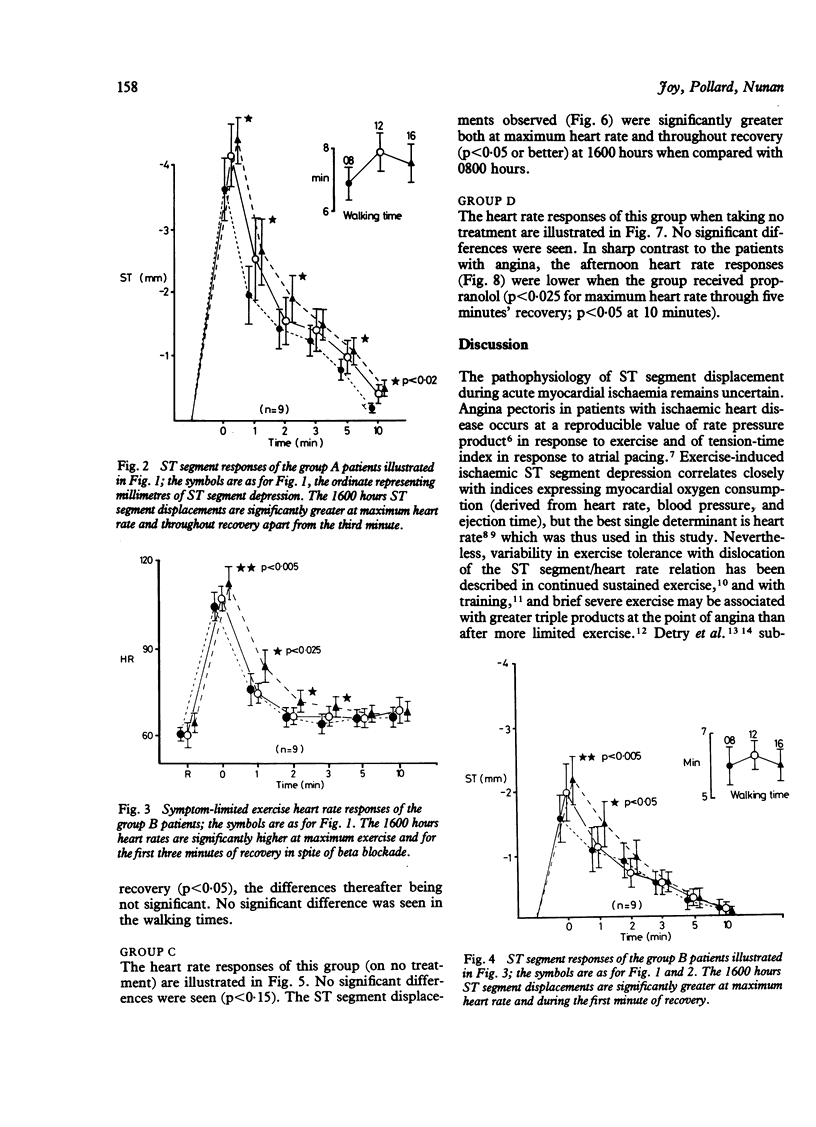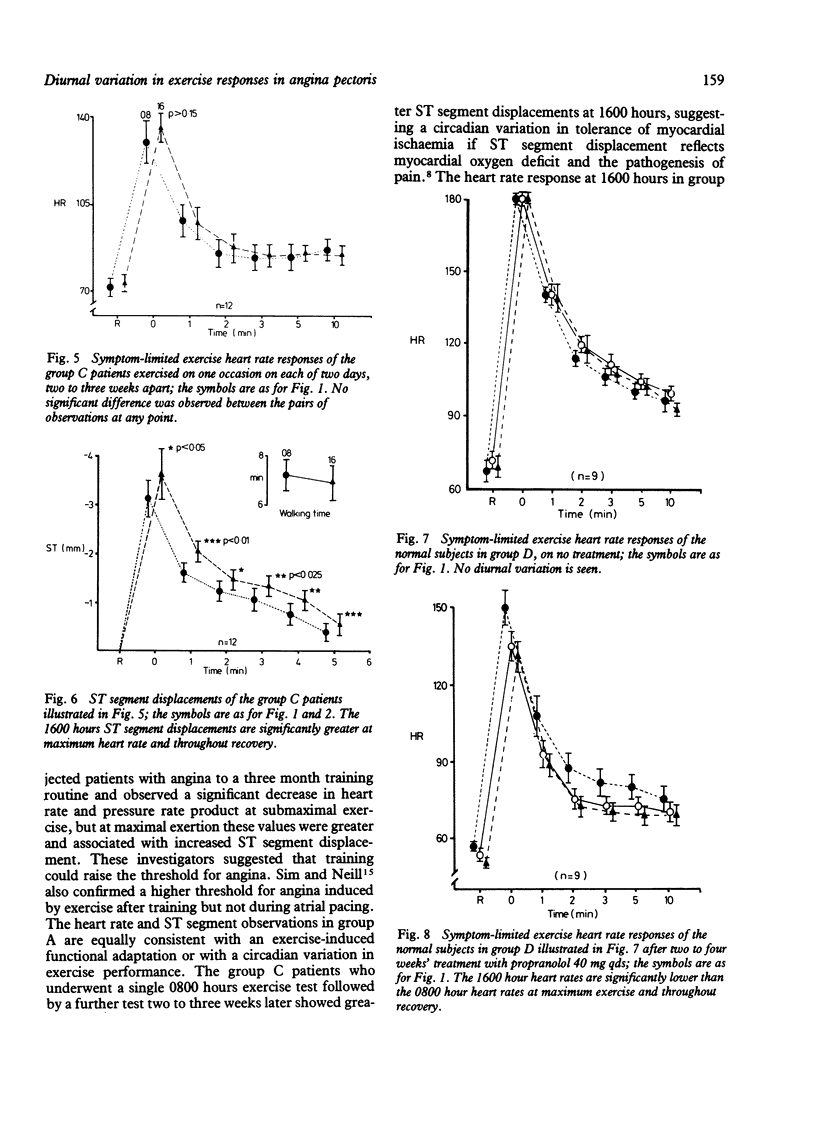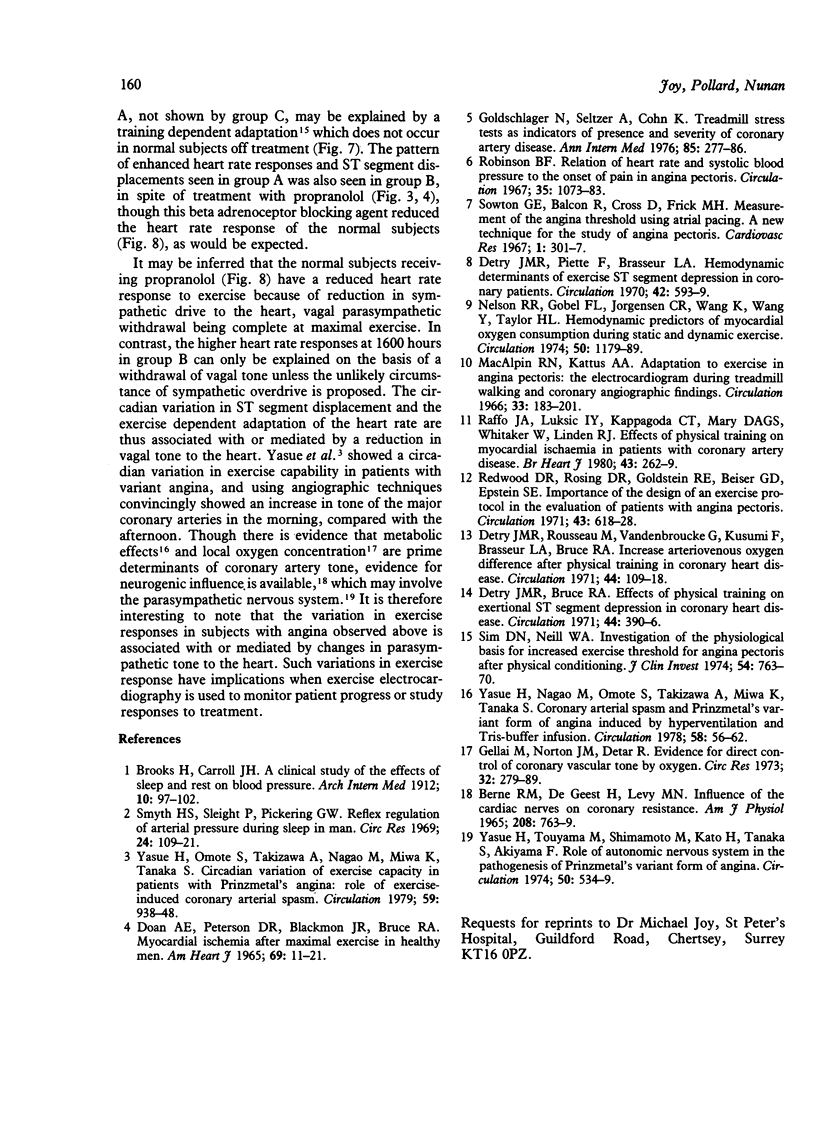Abstract
Thirty caucasian male patients with stable angina were investigated in two groups of nine and one group of 12. Nine normal subjects were also studied. Patients in the first group (on no treatment) underwent symptom-limited exercise electrocardiography at 0800, 1200, and 1600 hours on the same day. Their heart rates and ST segment displacements at 1600 hours were significantly greater than at 0800 hours and the same phenomenon was seen in the second group who had been receiving propranolol 40 mg four times a day. A similar effect was noted for ST segment displacement but not for heart rate in the third group (on no treatment) tested at 0800 hours and 1600 hours on separate days, two to three weeks apart. Normal control subjects showed no diurnal variation in heart rate and their heart rate responses at 1600 hours were reduced by propranolol. The observations show a circadian variation in the ST segment response to exercise in patients with angina and a possible training effect on heart rate with multiple exercise testing on the same day. This variation is associated with a reduction in vagal parasympathetic tone to the heart and should be taken into account in the assessment of patients with angina and in particular when comparing responses to treatment.
Full text
PDF




Selected References
These references are in PubMed. This may not be the complete list of references from this article.
- BERNE R. M., DEGEEST H., LEVY M. N. INFLUENCE OF THE CARDIAC NERVES ON CORONARY RESISTANCE. Am J Physiol. 1965 Apr;208:763–769. doi: 10.1152/ajplegacy.1965.208.4.763. [DOI] [PubMed] [Google Scholar]
- DOAN A. E., PETERSON D. R., BLACKMON J. R., BRUCE R. A. MYOCARDIAL ISCHEMIA AFTER MAXIMAL EXERCISE IN HEALTHY MEN. A METHOD FOR DETECTING POTENTIAL CORONARY HEART DISEASE? Am Heart J. 1965 Jan;69:11–21. doi: 10.1016/0002-8703(65)90211-5. [DOI] [PubMed] [Google Scholar]
- Detry J. M., Bruce R. A. Effects of physical training on exertional S-T-segment depression in coronary heart disease. Circulation. 1971 Sep;44(3):390–396. doi: 10.1161/01.cir.44.3.390. [DOI] [PubMed] [Google Scholar]
- Detry J. M., Piette F., Brasseur L. A. Hemodynamic determinants of exercise ST-segment depression in coronary patients. Circulation. 1970 Oct;42(4):593–599. doi: 10.1161/01.cir.42.4.593. [DOI] [PubMed] [Google Scholar]
- Detry J. M., Rousseau M., Vandenbroucke G., Kusumi F., Brasseur L. A., Bruce R. A. Increased arteriovenous oxygen difference after physical training in coronary heart disease. Circulation. 1971 Jul;44(1):109–118. doi: 10.1161/01.cir.44.1.109. [DOI] [PubMed] [Google Scholar]
- Gellai M., Norton J. M., Detar R. Evidence for direct control of coronary vascular tone by oxygen. Circ Res. 1973 Feb;32(2):279–289. doi: 10.1161/01.res.32.2.279. [DOI] [PubMed] [Google Scholar]
- Goldschlager N., Selzer A., Cohn K. Treadmill stress tests as indicators of presence and severity of coronary artery disease. Ann Intern Med. 1976 Sep;85(3):277–286. doi: 10.7326/0003-4819-85-3-277. [DOI] [PubMed] [Google Scholar]
- Nelson R. R., Gobel F. L., Jorgensen C. R., Wang K., Wang Y., Taylor H. L. Hemodynamic predictors of myocardial oxygen consumption during static and dynamic exercise. Circulation. 1974 Dec;50(6):1179–1189. doi: 10.1161/01.cir.50.6.1179. [DOI] [PubMed] [Google Scholar]
- Raffo J. A., Luksic I. Y., Kappagoda C. T., Mary D. A., Whitaker W., Linden R. J. Effects of physical training on myocardial ischaemia in patients with coronary artery disease. Br Heart J. 1980 Mar;43(3):262–269. doi: 10.1136/hrt.43.3.262. [DOI] [PMC free article] [PubMed] [Google Scholar]
- Redwood D. R., Rosing D. R., Goldstein R. E., Beiser G. D., Epstein S. E. Importance of the design of an exercise protocol in the evaluation of patients with angina pectoris. Circulation. 1971 May;43(5):618–628. doi: 10.1161/01.cir.43.5.618. [DOI] [PubMed] [Google Scholar]
- Robinson B. F. Relation of heart rate and systolic blood pressure to the onset of pain in angina pectoris. Circulation. 1967 Jun;35(6):1073–1083. doi: 10.1161/01.cir.35.6.1073. [DOI] [PubMed] [Google Scholar]
- Sim D. N., Neill W. A. Investigation of the physiological basis for increased exercise threshold for angina pectoris after physical conditioning. J Clin Invest. 1974 Sep;54(3):763–770. doi: 10.1172/JCI107814. [DOI] [PMC free article] [PubMed] [Google Scholar]
- Smyth H. S., Sleight P., Pickering G. W. Reflex regulation of arterial pressure during sleep in man. A quantitative method of assessing baroreflex sensitivity. Circ Res. 1969 Jan;24(1):109–121. doi: 10.1161/01.res.24.1.109. [DOI] [PubMed] [Google Scholar]
- Sowton G. E., Balcon R., Cross D., Frick M. H. Measurement of the angina threshold using atrial pacing. A new technique for the study of angina pectoris. Cardiovasc Res. 1967 Oct;1(4):301–307. doi: 10.1093/cvr/1.4.301. [DOI] [PubMed] [Google Scholar]
- Yasue H., Nagao M., Omote S., Takizawa A., Miwa K., Tanaka S. Coronary arterial spasm and Prinzmetal's variant form of angina induced by hyperventilation and Tris-buffer infusion. Circulation. 1978 Jul;58(1):56–62. doi: 10.1161/01.cir.58.1.56. [DOI] [PubMed] [Google Scholar]
- Yasue H., Omote S., Takizawa A., Nagao M., Miwa K., Tanaka S. Circadian variation of exercise capacity in patients with Prinzmetal's variant angina: role of exercise-induced coronary arterial spasm. Circulation. 1979 May;59(5):938–948. doi: 10.1161/01.cir.59.5.938. [DOI] [PubMed] [Google Scholar]
- Yasue H., Touyama M., Shimamoto M., Kato H., Tanaka S. Role of autonomic nervous system in the pathogenesis of Prinzmetal's variant form of angina. Circulation. 1974 Sep;50(3):534–539. doi: 10.1161/01.cir.50.3.534. [DOI] [PubMed] [Google Scholar]


